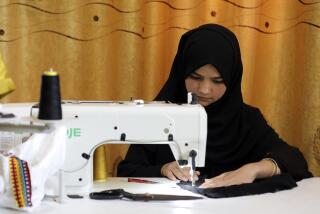Afghan Street Photographers Offer a Snapshot of the Past
KABUL, Afghanistan — The photographer poses his subject in a high-backed chair, peers into a bulky, wooden box camera on a rickety tripod, then whips off the lens cap and silently counts a seven-second exposure.
It could be a snapshot from a bygone age, when negatives were made of glass, long-suffering portraitists lugged around portable darkrooms and getting one’s picture taken was special, even extraordinary.
But in much of modern Afghanistan, this is still what passes for a snapshot booth.
A dozen or so photographers using Victorian-era technology set up shop at Kabul’s busy Sadorat intersection each morning, competing for trade with more upscale photo shops that boast newfangled digital cameras.
With most Kabulis struggling to get by on less than a dollar a day, the black-and-white prints from the street photographers -- processed by hand inside the cameras -- suffice for slapping on official forms and identity cards. The fee is 30 afghanis, or 60 cents, for a set of four, a quarter the price charged by shops.
It’s also quick.
“If you go to the photo shops, it takes a long time -- three or four hours -- to get your picture,” said Najibullah, 27, who has been pitching his homemade camera on the same street for 13 years. “I can do it in 10 minutes.”
His alfresco studio is a steel chair with a brown blanket draped over the high back for a backdrop. Discarded bits of white photo paper litter the dusty ground like hair clippings at a barber’s shop.
The Taliban religious army, which ruled for five years until its ouster by U.S.-led forces in late 2001, frowned on photography. But Najibullah kept working, although he wasn’t allowed to take pictures of women.
The camera is wooden, covered in red linoleum to make it waterproof and to shut out unwanted light. The only imported component is a Russian lens.
The back opens to reveal a screen attached to a retractable lever that is maneuvered until the upside-down image is in focus. Najibullah then closes the back, and sticks one arm into a lightproof opening in the camera’s side to insert a piece of photographic paper that will record the image. He then gets his subject to sit still and takes the photo by removing the lens cap. He exposes the film for about one second on a sunny day, about seven seconds with a wide aperture if it’s dull and cloudy.
That done, his right arm again burrows into the camera. With one eye pinned to a tiny peephole, he processes the photo paper in two mini trays of chemicals inside. “How long I put the paper in the developer depends on the weather,” said Najibullah, who like many Afghans has just one name.
If it’s hot, the chemicals work fast, so it might be just a second or two. On a wintry afternoon, it takes about 40 seconds before a negative image is revealed.
To get a positive image, he then repeats the process, only this time taking a picture of the negative using an easel he attaches to the front of the camera.
The final print -- rinsed off in a bucket of murky water -- is adequate, but won’t win any technical awards. It can be used on most Afghan documents, but not passports, which require color.
“It’s cheap, it’s fast,” said Abdul Mohim, 25, who has stopped by for reprints done for his father to put on an application for retirement from government service. “If I go to the photo shop, they’ll probably tell me, ‘Come back tomorrow.’ ”
But with computer technology sprouting in Kabul’s photo shops, time is catching up with the box-camera photographers. Visiting foreigners often buy their equipment as souvenirs.
The cameras themselves may only be a few years old, but the simple yet ingenious design is reminiscent of a 19th century period piece. It doesn’t use a shutter, a component introduced in the 1860s that made it possible to freeze action.
Najibullah is saving to open a photo shop of his own. “That will probably be a long time from now, when people won’t want this kind of black-and-white photo anymore,” he said. “So I’ll have to use digital too.”
More to Read
Sign up for Essential California
The most important California stories and recommendations in your inbox every morning.
You may occasionally receive promotional content from the Los Angeles Times.










